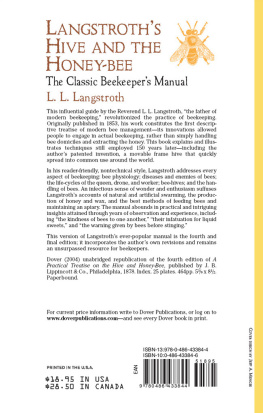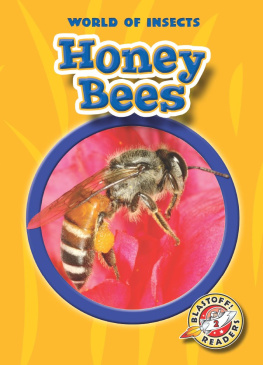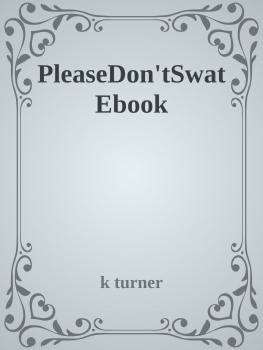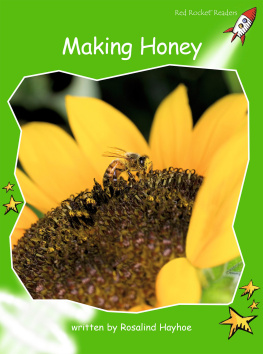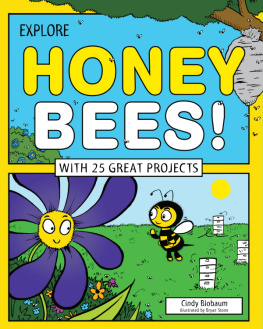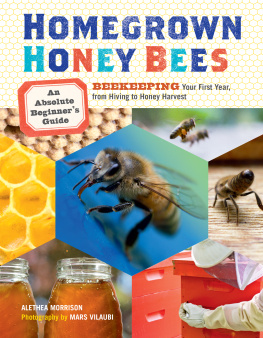Stephen Buchmann - Honey Bees: Letters from the Hive: A History of Bees and Honey
Here you can read online Stephen Buchmann - Honey Bees: Letters from the Hive: A History of Bees and Honey full text of the book (entire story) in english for free. Download pdf and epub, get meaning, cover and reviews about this ebook. year: 2010, publisher: Random House Childrens Books, genre: Home and family. Description of the work, (preface) as well as reviews are available. Best literature library LitArk.com created for fans of good reading and offers a wide selection of genres:
Romance novel
Science fiction
Adventure
Detective
Science
History
Home and family
Prose
Art
Politics
Computer
Non-fiction
Religion
Business
Children
Humor
Choose a favorite category and find really read worthwhile books. Enjoy immersion in the world of imagination, feel the emotions of the characters or learn something new for yourself, make an fascinating discovery.

- Book:Honey Bees: Letters from the Hive: A History of Bees and Honey
- Author:
- Publisher:Random House Childrens Books
- Genre:
- Year:2010
- Rating:3 / 5
- Favourites:Add to favourites
- Your mark:
- 60
- 1
- 2
- 3
- 4
- 5
Honey Bees: Letters from the Hive: A History of Bees and Honey: summary, description and annotation
We offer to read an annotation, description, summary or preface (depends on what the author of the book "Honey Bees: Letters from the Hive: A History of Bees and Honey" wrote himself). If you haven't found the necessary information about the book — write in the comments, we will try to find it.
Stephen Buchmann: author's other books
Who wrote Honey Bees: Letters from the Hive: A History of Bees and Honey? Find out the surname, the name of the author of the book and a list of all author's works by series.
Honey Bees: Letters from the Hive: A History of Bees and Honey — read online for free the complete book (whole text) full work
Below is the text of the book, divided by pages. System saving the place of the last page read, allows you to conveniently read the book "Honey Bees: Letters from the Hive: A History of Bees and Honey" online for free, without having to search again every time where you left off. Put a bookmark, and you can go to the page where you finished reading at any time.
Font size:
Interval:
Bookmark:
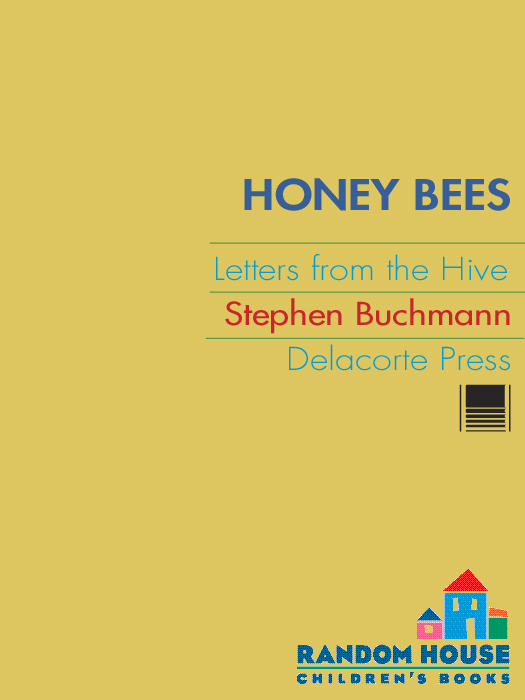

Chapter 1
Chapter 2
Chapter 3
Chapter 4
Chapter 5
The Beginning of an Enduring Passion:
Prehistoric Honey Hunters
Chapter 6
Chapter 7
Chapter 8
Chapter 9
Chapter 10
Dedicated to Pak Teh, a fine friend,
for sharing rituals during many Malaysian honey hunts.
With fondest memories
Salleh bin Mohammed Noor
(Jitra, Kedah Province)
(19252009)
Secrets of the Bee:
Abuzz with Activity
HONEY BEES LIVE in a world vastly different from ours. On a fresh spring morning a bee looks down on fields of colorful wildflowers through many-faceted compound eyes. A bee has five compound eyes, each with thousands of slender hairs growing from its surface. Through these hairy eyes, one would see vibrant colors and rapid movements inaccessible to the sensory powers of human beings.
While life on the wing could be magical, it would not be without risk. A bee could unwittingly fly into the snare of an orb-weaver spiders web or, ironically, find itself trapped in the folds of an entomologists aerial net, condemned to the bitter-almond vapors of the killing jar.
Honey bees savor tastes ranging from sweet to sour and back again, not only through cells in their mouth but also through sensitive hairs on their antennae. Bees would smell not through a big, protuberant nose but through thousands of minute sensory pits scattered across the surface of their antennae. This is called olfaction and is extremely important for bees. Without it, bees wouldnt be able to locate flowers as easily, recognize nest mates, smell an intruder in the colony, detect alarm pheromones given off by colleagues who have spotted danger. Floral scents cling to bees hairy wax-covered bodies as insistently as the scent of a womans perfume clings to a mans jacket after dancing close. When bees return to the hive after a successful foraging trip, the clinging fragrances inform their sisters of the kinds of blossoms theyve visited during the day, a sort of travel log recording forays into floral landscapes, or bee pastures. More importantly, these scents help direct new recruits to the best sources of nectar and pollen.
The scents of the outside world dont mask the unique scent of the home nest, which is always there to serve as an olfactory identity badge. Guard bees sniff the body odor of workers returning from the field; if they smell something unfamiliar, the stranger is kept out or even attacked and killed if it persists in trying to enter.
If we could shrink ourselves down to bee size and enter the inner world of the nest, we would find it an alien place, dark, crowded, and oppressively hot and humid. But bees are not humans, and presumably they feel comfortable in the hive, which is home to a queen, tens of thousands of her daughters (sterile worker bees), and a few hundred or so of her sons, the drones. Double-sided hexagonal combs hang like graceful parallel curtains from the ceiling of the hive. Like large corporations that house thousands of employees in diminutive side-by-side cubicles, the beeswax nest is a highly compartmented and efficient workplace. The waxen cubicles serve a multitude of functions, from honey and pollen storage pantries and larval nurseries to dance floors for the waggle dancing of returning foragers.
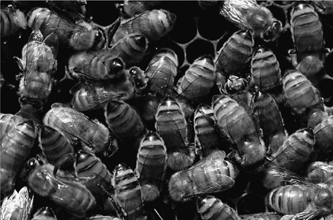
A tangle of worker bee bodies. The honey bee nest is a crowded place.
Waggle dancing is one of natures most fascinating means of communication. When a successful forager returns from the field with a special stomach (the crop) full of nectar or bulging hind-leg pollen baskets, she performs a lively dance on the vertical combsa little wagtail movement followed by a straight upward runthat imparts information to the bees watching and listening to the show. The spectators routinely beg for a sip of nectar from the obliging dancer, who takes a break to pass out free samples.
Karl von Frisch, an Austrian animal behaviorist who shared a Nobel Prize in physiology and medicine in 1973, spent decades studying what he called the dance language of the honey bees. Von Frisch determined that the straight-run portion of the waggle dance indicated the direction of the floral patch, while the vigor of the waggling, accompanied by pulsed buzzing vibrations, imparted the relative distance to the food. Dancing straight up on the combs indicated that the recruited bees should fly toward the sun to find the correct flowers. If the food was located in the opposite direction of the sun, the performer danced straight down on the combs of the nest. Odors also play a primary role in how bees locate and remember flowers. Foragers return to their nests with the lively scents of flowers clinging to their hairy bodies. Other bees smell these scents and it helps them to locate and recognize them far from the nest.
Beeswax, the building material of the hives interior, is biochemically expensive to make. It takes almost twenty pounds of honey, digested and biochemically transformed in the bees bodies (wax glands), to produce just one pound of the precious wax. This is why beekeepers often supply ready-made beeswax foundation sheets to their coloniestheyd rather have this honey for their own use, saving the bees some effort. Beeswax is secreted by eight paired glands under the abdomen of the bee, then chewed and softened until it is pliable enough to be shaped into the thin-walled hexagonal cells of the combs.
How the geometric combs are constructed by the workers without a supervisor, blueprints, rulers, or protractors remains a mystery. Previously, scientists believed that the precision of the hexagonal cells was the result of an instinctive behavior that stimulated the bees to add, remove, and fashion the wax in just the right way to ensure that the walls and angles were all perfectly aligned. Recently, it has been suggested that the hexagonal cells are an emergent property, that is, at the right temperature (between 37 and 40C), the hexagons form on their own. First the bees make cylindrical tubes around themselves and then the hexagonal angles form. Chemically, the beeswax transforms from an amorphous (or unorganized) state into a crystalline state. As strange as this sounds, look at the angles where soap bubbles touch one another to form 120-degree angles. Or roll out some clay cylinders the thickness of a pencil with your hands. Take ten or so and wrap them in a cardboard sleeve. Squeeze them together slowly. You get hexagons! Hexagons are found in other examples of animal architecture, like wasp nests or under the sea in the hard limey skeletons of corals.
The drones follow a seductive chemical pheromone trail released by queens, who are virgins and ready to mate. A healthy queen mates with seven to ten drones on a given mating flight. She may make a number of mating flights over the course of several subsequent days.
Two to four days after her mating flights, the queen returns to the colony, which she will never leave again, to begin her new role as an egg layer. A longer version of her daughters, with an elongated abdomen, she can lay up to fifteen hundred eggs a day throughout her life of one to three years, for a possible grand total of six hundred thousand progeny. When shes ready to lay, the queen walks over the surface of the combs in the brood nest, the central part of the nest, searching for empty cells that have been cleaned. When she finds an acceptable cell, she backs into it and lays a single, brilliant white egg, then backs out and moves ona task that is repeated hundreds of times a day, every day of her life, except during the winter.
Font size:
Interval:
Bookmark:
Similar books «Honey Bees: Letters from the Hive: A History of Bees and Honey»
Look at similar books to Honey Bees: Letters from the Hive: A History of Bees and Honey. We have selected literature similar in name and meaning in the hope of providing readers with more options to find new, interesting, not yet read works.
Discussion, reviews of the book Honey Bees: Letters from the Hive: A History of Bees and Honey and just readers' own opinions. Leave your comments, write what you think about the work, its meaning or the main characters. Specify what exactly you liked and what you didn't like, and why you think so.

